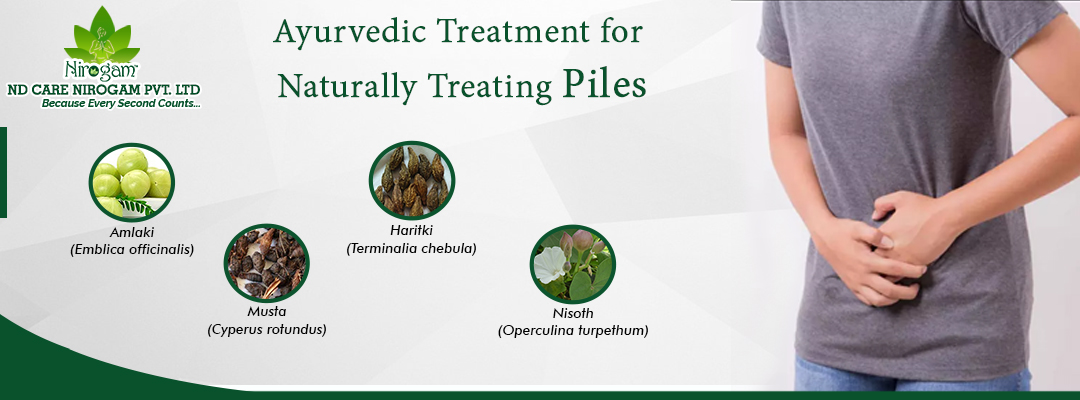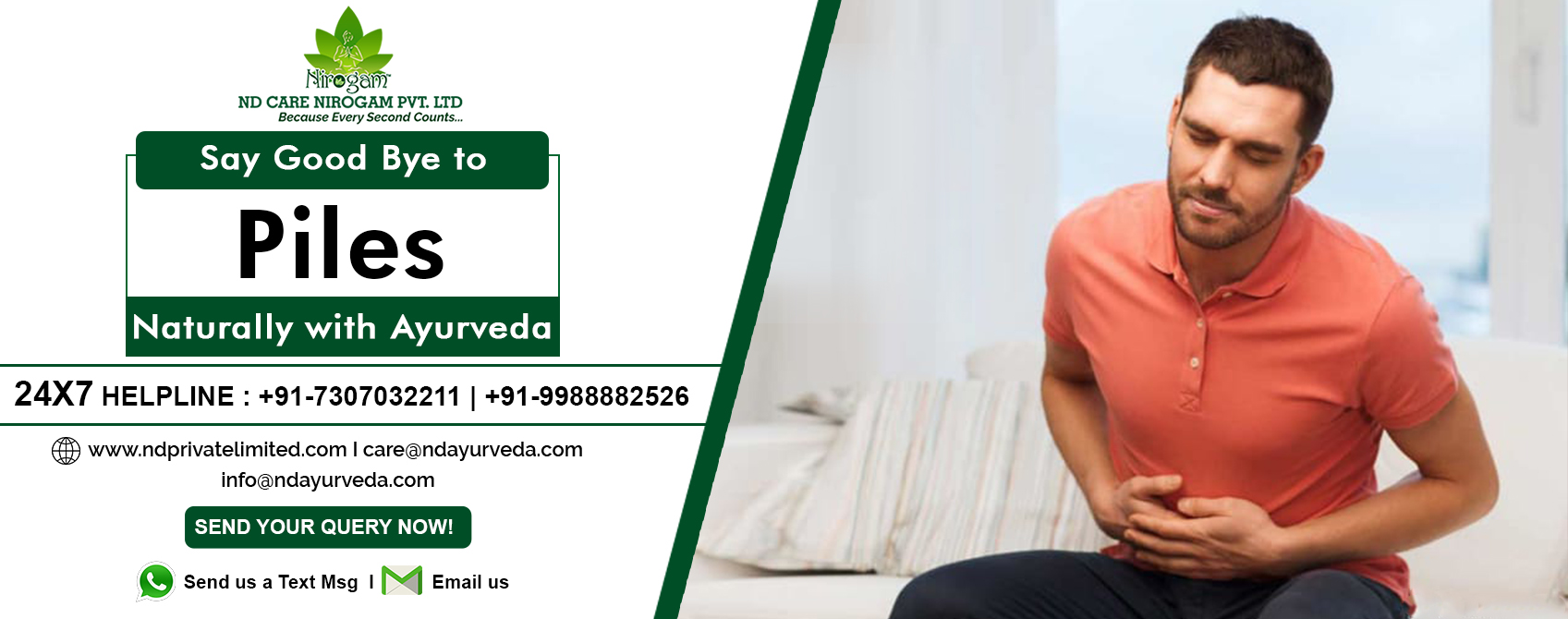Ayurvedic treatment of piles (Haemorrhoids / Cushions)
Haemorrhoids/Cushions are a diseased condition, commonly known as piles. The symptoms of piles match well with Arsha. It has been mentioned in Ayurveda that due to faulty dietary habits and sedentary lifestyle, digestion becomes weak (Mandagni) and as a result, the excess accumulation of Mala (waste) occurs in the body. In addition to that, due to various faulty habits, vitiation of Apana Vayu occurs, which causes more obstruction of Mala and pushes it inside, ultimately resulting in the formation of Arsha. Weak digestion and constipation, being major causative factors for piles, the treatment is focused to promote healthy digestion. Ayurveda tackles piles with the customized diet and lifestyle modifications. In addition to that, Ayurvedic healers emphasize regularizing bowel movements. In Ayurvedic prescription for piles, specific combinations of advanced detoxification ingredients are recommended to cleanse the accumulated Ama (Toxins) along with tailor-made wellness products to enhance digestion.

Ayurvedic concept for treating piles naturally
We, at ND Care Nirogam Pvt. Ltd., refer to piles (external/internal haemorrhoids) as a disease which tortures patient's vital force (Prana). Basically, piles are a kind of swelling of anal vasculature which obstructs defecation and causes intensive hurting to the patient. Evident from the Shloka below: -

In Ayurveda, piles / Arsha occurs due to the enlargement of the blood vessels in the anal region.
In Ayurveda Arshas are categorized into two types
Type 1: Sraavi Arsha (bleeding piles) & Type 2: Shushka Arsha (dry piles)

-
The treatment of piles targets the tissues viz. Medas (fat tissue), Mamsa (muscle tissue), and Tvak (skin including mucous membrane), which are the main seats of Arshas. The piles treatment protocol (piles reduction) targets the main symptoms to provide immediate relief and to eradicate the root cause of the piles without any surgical interventions.
- According to our several case studies of piles, it is apparent that, often one or more of the Doshas may be aggravated. Hence, we focus to remove the root cause of the piles. In this regard, we recommend following certain foods and lifestyle habits that help in maintaining the balance of the Tridoshas..
As mentioned in Ayurveda, derangement in Agni (metabolism) is the basic cause of Arsha. We, at ND Care Nirogam Pvt. Ltd., provide "Deepaniya Dravyas" and "Shrotoshodhak Dravyas" as natural remedies for treating piles. The "Deepaniya Dravyas" enhance digestion to prevent accumulation of toxins (Ama) by increasing the Agni (digestive fire) and the "Shrotoshodhak Dravyas" help in clearing the Malas (waste) of the body.
Nirogamz Bowel care" Natural Ayurvedic solution for Piles"
- Supports the digestive system & excretory system.
- Promotes the easy daily bowel movement and reduces rectal itching.
- Ensures pain free fecal excretion.
Virechana "Natural Ayurvedic care for Piles"
- Natural mild laxatives to regularize bowel mobility.
- Relieves the symptoms of fullness, bloating in the abdomen & constipation.
- Removes toxins from the body naturally.

The advantage of our Ayurvedic treatment of piles is that it treats piles naturally and saves the patient from surgery. Our Ayurvedic scholars and dedicated researchers have formulated unique blends that help to eliminate the recurrence of the disease. Piles need strict diet and lifestyle pattern according to individual's Prakriti. We also recommend modulation in the lifestyle of the patient that helps in speedy recovery from piles and prevent recurrence.

What are Piles?
Piles are ordinary anatomical parts of the human body which are located at the junction of small arteries and veins. In physiological terms, piles are the accumulation of inflamed and swollen tissues/enlarged blood vessels in anal canal (smooth muscles). Such inflamed tissues often contain blood vessels, elastic fibers, muscle, and support tissue. Piles can appear in a range of sizes along with internal or external presence. The internal piles are located up to 2 - 4 (cm) above (pectinate line) the anal opening whereas, the external piles can occur on the outer edge of the anal opening.
Piles are classified into four grades/classes
Grade I Piles: Grade-I piles are characterized by non-visible smaller inflammations on the inner anal lining and bleeding (Hematochezia) is the only sign of their presence.
Grade II Piles: Grade II piles are non-visible bigger inflammations of inner anal lining and may get pushed out during defecation.
Grade III Piles: Grade III piles are also known as prolapsed hemorrhoids and are visible (outside the anal sphincter) bigger inflammations.
Grade IV Piles: Grade IV piles are bigger inflammations that need treatment and often remain outside of the anus. These lumps are very itchy and can also be painful (a condition known as thrombosis) in the case of a blood clot development. In this case, bleeding is common after passing a stool.

Ayurvedic herbs for natural pile treatment
Nisoth (Operculina turpethum): - Being purgative in nature, it helps in easy stool passing and thus prevents constipation. It is very useful in hemorrhoids and provides relief from associated symptoms like itching, irritation, redness, and swelling around the anus region due to its ant inflammation properties.
Haritki (Terminalia chebula): - Being anti-inflammatory in nature, it reduces inflammation and swelling. It also prevents infection due to its anti-bacterial property. It suppresses hyperacidity and helps in digestion by increasing digestive enzymes and prevents constipation that is the main cause of piles.
Musta (Cyperus rotundus): - It has Katu (pungent), Tikta (bitter) and Kashaya (astringent) taste; Laghu (light) and Ruksha (dry) properties. It reduces Kapha and Pitta Dosha, increases digestion, and digests the undigested material and acts as anti-itching. It is widely used in the management of fevers, diarrhoea, thirst, inflammation, helminthiasis, indigestion and obesity. Due to its anti-inflammatory and digestive nature, it helps in the treatment of piles naturally.
Amlaki (Emblica officinalis): - It is rich in Vit. C and has anti-bacterial and analgesic property. The green fruits stimulate appetite. It is extensively used as a laxative as one of the constituents of Triphala.

Home remedies to combat piles
- Fruits like Isabgol, dried figs, Amalaki, and papaya may act as natural stool softeners which ensure a thoroughly cleansed colon.
- Exercise regularly but, avoid heavy exercise.
- Avoid excessive or abnormal sex as it can also lead to aggravation of the symptoms of piles.
- Use soft cushioned seats.

Diet for piles: Piles treatment diet
- Eat high fiber rich foods.
- Eat lots of fresh fruits and vegetables.
- Eat wholegrain cereals.
- Pulses (peas, beans, and lentils) should be added in the diet.
- Drink plenty of water.
- Avoid caffeinated products like coffee, tea, chocolate.
- Avoid red meat or processed meat.
- Avoid spicy food especially chilies.
- Avoid bakery products made from refined flour bread, cakes, pastries, pies, and puffs.

Piles treatment by Yoga
Ashwini mudra- Contraction and relaxation of buttock muscles help in getting relief from pain, burning and itching sensation and from hemorrhoids also.
Mulabandhasana- Contraction of pelvic floor muscles and lower abdominal muscles contraction rejuvenates and restores normal anal function.

Pranayama for piles
Bhastrika- Inhalation brings in positivity and exhaling leads to release of negativity and toxins which purifies our blood. It exhibits great psychological effects on our minds.
Nadishodhana- When we breathe from our right nostril, left hemisphere gets revived and vice versa. Additionally, the alternate supply of air to lungs improves respiratory system function.

Exercise for piles
Kegel exercises - Strengthen muscles in the pelvic and anal region. It relieves stress, incontinence, and hemorrhoids.
Brisk walking - Walking slowly and then increasing the pace for 20-45 minutes can help in treating piles.
Ayurvedic Treatment for Piles
Best Ayurvedic Medicine for Treatment of Piles: Without Surgery
Natural Remedies for Treatment of Piles
Ayurvedic Therapies for Treatment of Piles
Home Remedies for Treatment of Piles
Yoga, Pranayama, Exercises, Diet Chart for Treatment of Piles
